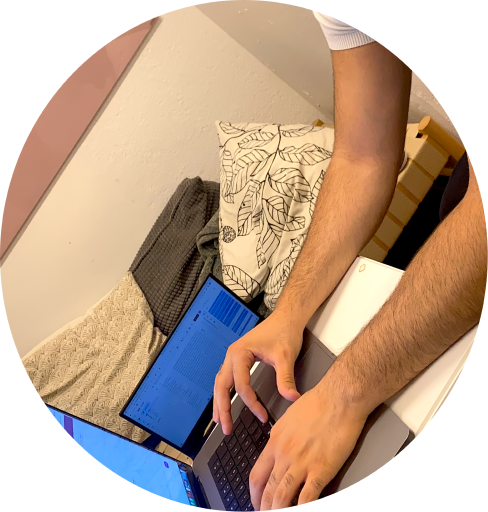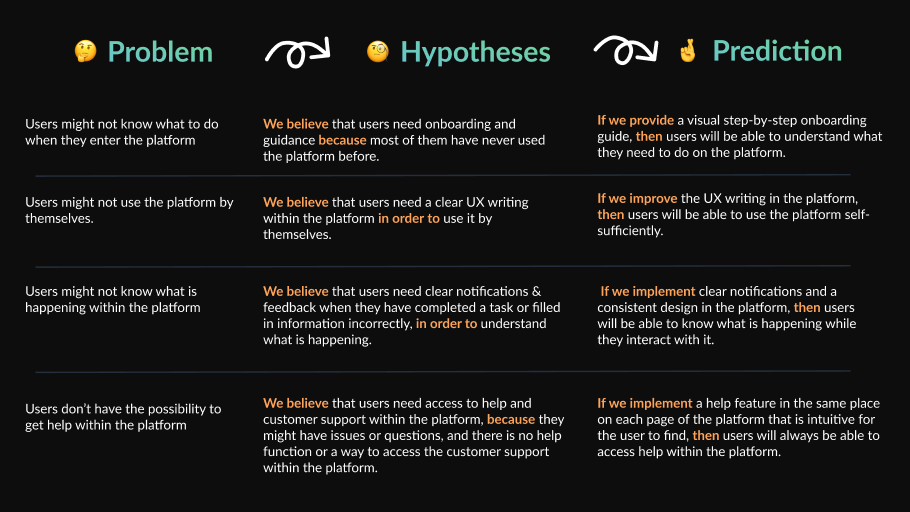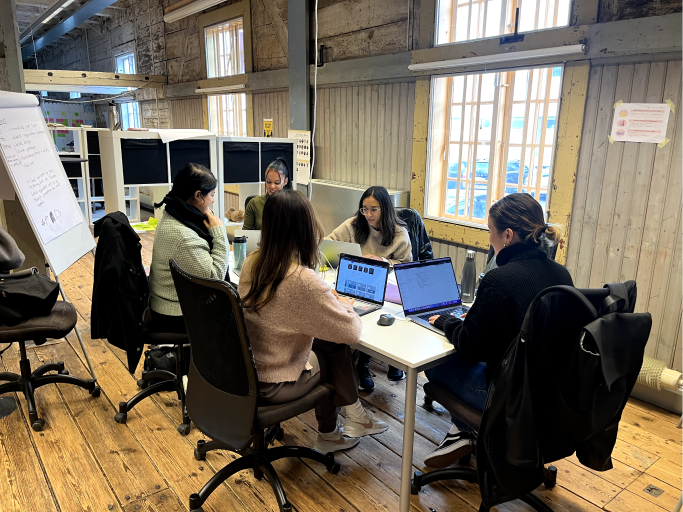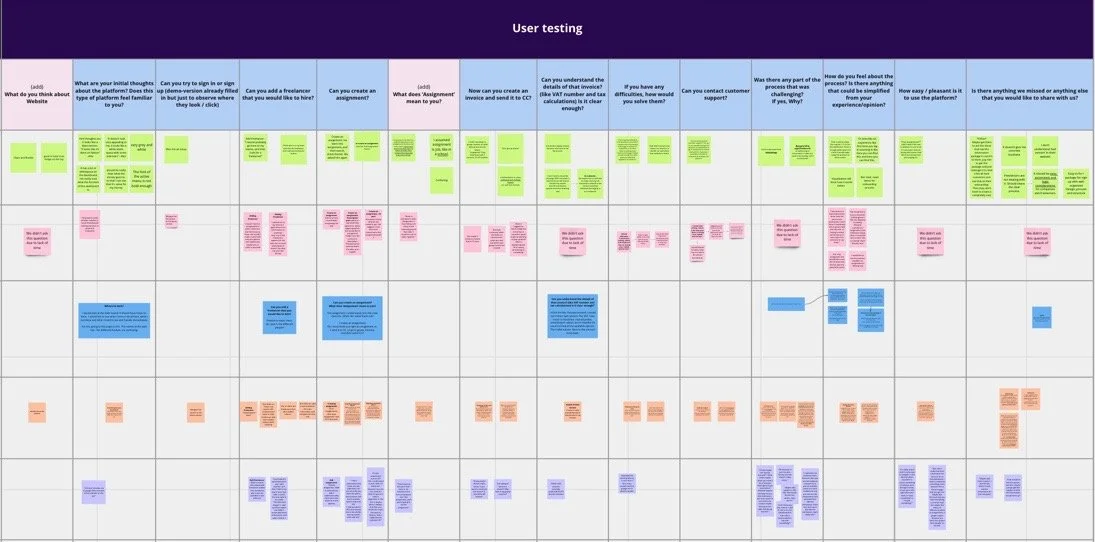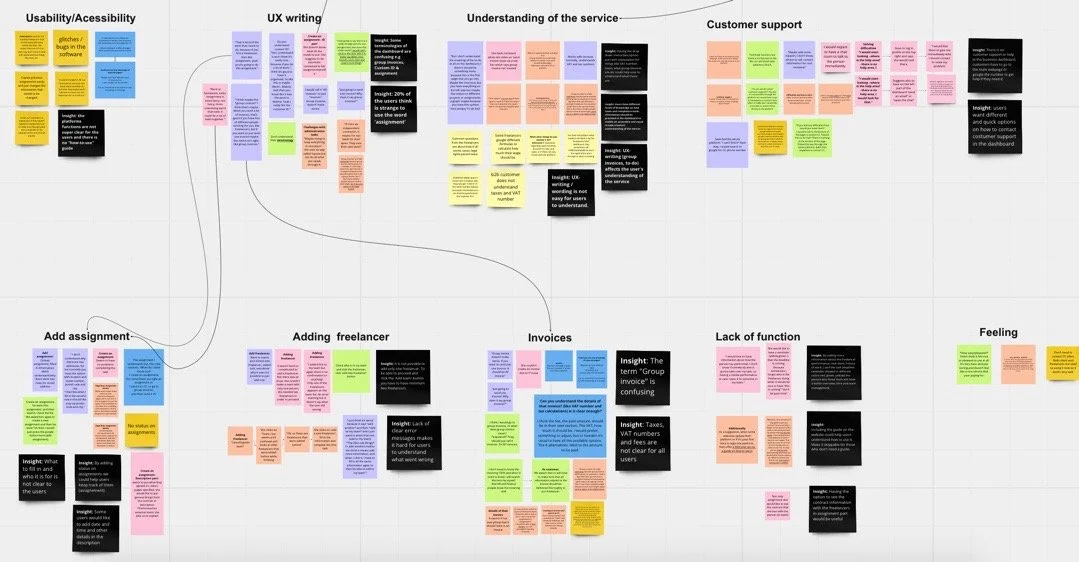Roles & Responsibilities:
Project Context:
UX Researcher: secondary research, user testing, analysing and synthesising data.
UX Designer: brainstorm, wireframe, prototype.
Scrum Master.
11 weeks project: autumn 2021.
The client: Cool Company.
Collaborative project with Linnea Hellberg, Hyonie JeongHyun Kim, Rojin Kolanc, and Violeta Vukelic.
The brief
Redesign Cool Company’s B2B platform based on user insights with the aim of it being a self-service platform while also aligning it with their current B2C platform, and delivering design improvement suggestions that communicate Cool Company’s brand identity.
The Process
Discover
Discover, Define & Empathize
Ideate, Sketch, Prototype, Test & Iterate
Prepare & Present
Debrief
Desk Research
Interviews with stakeholders
User testing
User Flow / Personas / Storyboards
Synthesize data, HMW & hypothesis
Brainstorming
Pen & paper wireframes
Mid-Fi / User testing / Iterate
Hi-Fi / User testing / Iterate
Prototype
Prototype
Prepare presentation
Present for Cool Company
Define
Develop
“I can’t contact them (Customer Support) in the platform. There is nowhere on here anything about contact”
Tools used:
Understand the B2B platform (Business Dashboard)
Gather insights from customers
Figure out why it’s complicated to use
Working according to the Double Diamond method…
Transparent, effortless, fast and seamless experience
Platforms with a clean design
Highlights customer’s benefits in their dashboard menu
Clear and catching UX writing
Service & Usability
Text guide under each steep and optional pop ups boxes explaining how it works
Deel has an automated onboarding that synchronizes with the HR platform
Frilans Finans’ platform has all the information on one page
Design
Interviews + User testing
As our goal was to gain information and deeply understand users’ pain points, we conducted interviews with Cool Company’s customer support team as well as the head of B2B team & IT. We also conducted five interviews and user tests with people from diverse backgrounds who have their own companies and who have experience or are willing to hire freelancers. It was super valuable for us to observe how they interact with the platform and to hear about their thoughts and feelings while using it.
Once we were done with the interviews and user tests we could start synthesising and clustering all the information to see connections and patterns in their behaviours, thoughts, and feelings. We saw a lot of recurring feedback and behaviour despite the participants' different previous knowledge and experiences.
User Personas
Our main research findings were:
They have no real introduction or guide of the b2b platform and there is no customer support available on the platform.
Unnecessary steps combined with unclear UX writing in the b2b platform make it more difficult for users to understand.
Insight 💡
Insight 💡
Insight 💡
Unnecessary steps & functions make the platform complicated to use.
From these insights we created our hypothesis and How Might We related to our main research findings: Lack of onboarding for new users, unclear UX writing, lack of clear notifications or feedback in the platform, and no help function or customer support within the platform.
Delivery
“I think like, how do I add to the to-do list?
Is there like a button where I can add something?”
”
“I’ve used these kinds of tools before and they’re terrible! So this is a huge change in that sense, it’s very easy to do, it explains things and that’s the most important thing to do.”
Competitive Analysis
We started by doing desk research about Cool Company’s main competitors. There are competitors based in Sweden and in the USA. All of them provide both B2B and B2C services. Deel and Remote, also give the opportunity for companies to hire freelancers from any country in the world. Our main findings were:
Synthesising + Clustering
The problem statement in our brief was based on internal opinions. (“That the platform is too complicated for customers to use”)
Only 2 customers are currently using the b2b platform, the majority of cool companys’ b2b clients have never been introduced to it.
There is no standardised onboarding process for new clients - it varies from client to client, and sometimes there is no onboarding.
Insight 💡
There is a lack of accessible help with customer support in the platform.
Their Inconsistent onboarding process and lack of a guide in the platform hinders users' self sufficiency.
Unclear UX writing affects the user in a negative way and creates misunderstandings.
“How Might We help users understand every part of the process and be able to use the platform self-sufficiently?”
To better understand and empathize with the users’ needs and pain points, we created multiple user personas based on the personas we got from Cool Company combined with users from our own user tests.
Ideating
Our ideation phase started with looking for some inspiration from Cool Company’s competitors and other sources and creating mood boards. Then we created Pen & Paper wireframes to ideate around different ideas. Then we moved to mid-fi, and repeated the process again.
Once our mid-fi prototypes were ready to be tested we carried out on-site and remote usability testing and asked them questions related to 4 categories: onboarding, quick guides added on 4 main pages (Team, Assignment, Time report, and Invoice), UX writing, and help function. Furthermore, we asked them to freely share their thoughts and feelings regarding our design or any additional specific feedback. We also did ABC testing with 8 participants in order to test small details.
“The guide should be fairly limited, and the way that you’ve done it is really good. Because if the guide is too extensive the design is not that great.”
“Usually I would just click my way through it, and since the dashboard feels pretty close to the Deel feel, I kind of recognise it.”
Takeaways
Below you can check the result of the final design that we created for Cool Company. The focus were the onboarding (on the dashboard), quick guides in all 4 pages, clear UX writing and the help function within the platform.
Certainly being aligned as a team throughout the entire project helped us to move on and adapt to the new challenges that we had along the way. We constantly practiced open and effective communication both internally and externally with the client in order to achieve a great outcome and reach the goals that were expected of us.
Regarding user research, my main takeaway from this project is that as UX designers we won’t always have easy access to all information, so it’s important to be proactive and make it happen, be creative in finding solutions and adapt to the situation. Our main research goal was to understand the WHY, why the platform was complicated to use. Besides all interviews and user testing that we conducted, extending our research on competitors and stakeholders who had daily contact with the users certainly helped us to gain knowledge about the users’ needs and pain points.
Iterate as much as you can. To make sure that our design was based on data and with intention, we did 3 rounds of user testing with 5-8 participants in each.
Last but not least, while being a scrum master I cared about inclusion since we worked both on-site and remotely, it is important that everyone feels included and aware of what is happening and the decisions made by the team regarding the project. I would document everything that happened during the day, from what we have done, and the decisions that we made, to what would be our next steps. This helped us to keep aligned and structured as a team. I very much enjoyed facilitating our daily check-ins and check-outs. It was a moment when I could feel the energy of the team, and create space for reflection on what were the challenges and distractions. I believe that the role of the scrum master is to encourage the team and help to create an environment where everyone feels safe to be themselves, so the team members can work effectively. At the same time, I believe that everyone has a responsibility to make this happen, therefore it’s equally important for each team member to have a self-leadership mindset.
B2B Platform - Redesign Project
Figma
Miro
Google Docs
The current B2B platform is not based on customers’ insights and it’s quite complicated to use
Research goals:
“Am I just going to send one invoice? Why does it say group invoices?”




